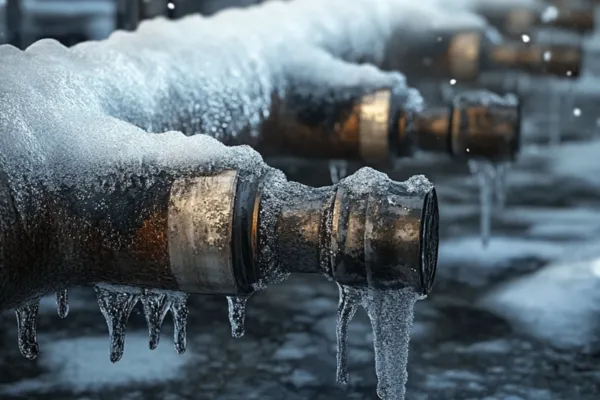
Rosedale Plumbing Journal
By The Plumbing Doc

Winterize Your Pipes: Prevent Freezing and Cracks
Understanding the Risks of Unprotected Pipes in Winter
Winter brings many challenges, particularly for your home's plumbing system. Here's a deeper look at the risks associated with unprotected pipes during freezing temperatures:
Freeze and Burst Cycle:
Freezing: When temperatures drop below freezing, the water inside exposed pipes can freeze. As water freezes, it expands by about 9%, which can cause pipes, especially those made of copper or rigid plastic, to stretch and eventually split.
Bursting: Once the ice blockage builds enough pressure in the pipe, it can rupture. This often occurs not where the ice has formed but rather in the pipe just beyond the frozen area, where water pressure from the main supply continues to build.
Water Supply Disruption:
A frozen pipe blocks the flow of water, potentially cutting off supply to an entire section of your home or even the entire property. This disruption can last from several hours to days, depending on the extent of the freeze and the repair time required.
Extensive Home Damage:
Flooding: When the ice thaws, water from the broken pipe floods the home. This sudden release can lead to extensive water damage, affecting floors, walls, furniture, and even the structural integrity of your home.
Mold and Mildew: Damp conditions from flooding promote rapid growth of mold and mildew, which can degrade air quality and cause health problems.
Electrical Risks: Water from burst pipes can also infiltrate electrical systems, raising the risk of short circuits and potential fire hazards.
Costly Repairs and High Expenses:
Plumbing Repairs: Repairing a burst pipe often involves replacing sections of pipe and sometimes the entire system if damage is extensive.
Home Restoration: Water damage from burst pipes often requires professional cleanup services, drywall repairs, and sometimes even major renovations.
Increased Insurance Premiums: Frequent claims from water damage can lead to higher home insurance premiums.
Step-by-Step Guide to Winterizing Your Pipes
Winterizing your home's plumbing system is crucial to avoid the inconvenient and costly consequences of frozen and burst pipes. Here’s a comprehensive guide to protect your pipes as temperatures drop:
Insulate Pipes:
Choose the Right Insulation: Use foam pipe insulation sleeves for easy application. These sleeves are affordable and available at most hardware stores.
Focus Areas: Prioritize pipes in unheated areas such as attics, garages, and basements. Ensure that pipes running along exterior walls and in other vulnerable areas are also insulated.
Installation Tips: Make sure the insulation covers the entire length of the pipe without gaps. Use duct tape to secure the insulation at seams and bends for additional protection.
Seal Leaks:
Identify Leak Points: Check around your home for any drafts that could affect your pipes, particularly where they run through external walls.
Seal Drafts: Use caulk or spray foam insulation to seal gaps around holes where pipes, cables, and wires enter your home. This will help maintain warmer air inside and block cold air.
Faucet Covers:
Install Covers on Outdoor Faucets: These covers are an effective and inexpensive solution to prevent outdoor faucets from freezing.
Installation: They are typically made of insulated material and can be installed by simply slipping over the faucet and securing with a built-in fastening mechanism.
Drain Outdoor Lines:
Detach Hoses: Remove all garden hoses connected to outdoor faucets to prevent ice from forming in the hose and extending into the pipe.
Drain Pipes: Use indoor shut-off valves to cut water flow to outside faucets, then open the faucets outside to drain any remaining water.
Keep the Heat On:
Set a Minimum Temperature: Keep your home's thermostat set to at least 55 degrees Fahrenheit, even when you are away, to help ensure that the temperature inside the walls where pipes are located doesn't drop below freezing.
Open Cabinet Doors:
Promote Warm Air Circulation: Open cabinet doors under sinks and near appliances to allow warmer air to circulate around the plumbing, particularly if the pipes are in exterior walls.
Let Faucets Drip:
Prevent Pressure Buildup: Allow a slow drip from faucets connected to pipes that run through unheated or vulnerable areas. The moving water relieves pressure in the plumbing system and helps prevent freezing.
FAQs about Winter Plumbing Maintenance
Below, we answer some of the most common questions homeowners have about winter plumbing care, providing expert advice and practical tips.
What should I do if my pipes freeze?
If you discover a frozen pipe, the first step is to shut off the main water supply to reduce pressure on the frozen areas and minimize flooding if the pipe bursts. Apply gentle heat to the frozen section using an electric heating pad wrapped around the pipe, an electric hair dryer, or towels soaked in hot water. Avoid using open flame devices such as a blowtorch.
How can I tell if a pipe is frozen?
Common signs include reduced water pressure or no water coming out of the faucet. Pipes most at risk are those in unheated interior spaces such as basements, attics, and garages, and those running through cabinets or exterior walls.
Are certain pipes more prone to freezing?
Yes, pipes located in exterior walls, attics, and unheated basements are most susceptible. Pipes made from copper or other metals freeze more quickly than those made of plastic.
How often should I check my plumbing during winter?
Regular checks throughout the winter months are advisable, especially during particularly cold snaps. Inspect your pipes for signs of freezing or leaks at least once a month.
Is it safe to leave my house at a lower temperature when I’m not home?
To prevent freezing, it's recommended to keep your house temperature at no lower than 55 degrees Fahrenheit, even if you are not home.
What preventative maintenance can help reduce the risk of freezing pipes?
Have a plumber install insulation around pipes, particularly those in colder areas. Consider installing a monitored leak detection system to alert you to leaks or failures in the plumbing system.
Does draining my water system for winter help prevent issues?
Yes, if you plan to be away for an extended period during winter, draining the system can prevent water from freezing in the pipes. Turn off the main water valve and open all taps to let water run out, and don’t forget to flush toilets to clear water from the tanks.
Can I insulate pipes on my own, or should I hire a professional?
While you can insulate pipes yourself using foam pipe insulation from any hardware store, hiring a professional ensures that it is done thoroughly and correctly, especially in hard-to-reach areas.
Winterizing your plumbing is an essential step in preparing your home for the cold months. By taking proactive measures, you can avoid the inconvenience and expense of frozen and burst pipes. Contact The Plumbing Doc today to schedule a complete plumbing system check-up and ensure your home is ready for winter. Stay warm, stay safe, and let us help you keep the water flowing all season long.

Schedule a Professional Inspection
Ready to schedule a professional inspection? Contact us today.

